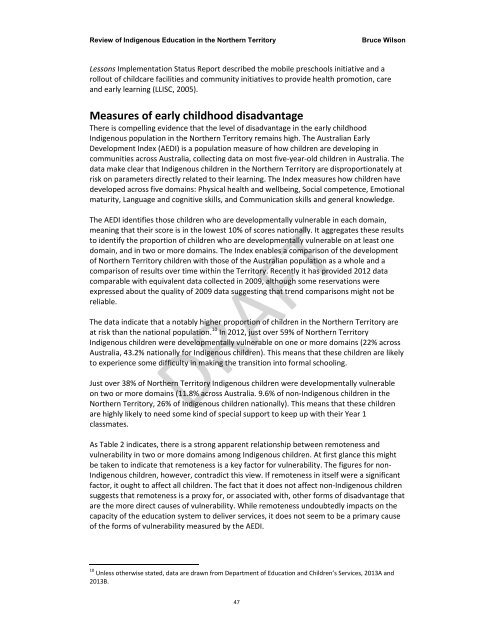Indigenous-Education-Review_DRAFT
Indigenous-Education-Review_DRAFT
Indigenous-Education-Review_DRAFT
You also want an ePaper? Increase the reach of your titles
YUMPU automatically turns print PDFs into web optimized ePapers that Google loves.
<strong>Review</strong> of <strong>Indigenous</strong> <strong>Education</strong> in the Northern Territory<br />
Bruce Wilson<br />
Lessons Implementation Status Report described the mobile preschools initiative and a<br />
rollout of childcare facilities and community initiatives to provide health promotion, care<br />
and early learning (LLISC, 2005).<br />
Measures of early childhood disadvantage<br />
There is compelling evidence that the level of disadvantage in the early childhood<br />
<strong>Indigenous</strong> population in the Northern Territory remains high. The Australian Early<br />
Development Index (AEDI) is a population measure of how children are developing in<br />
communities across Australia, collecting data on most five‐year‐old children in Australia. The<br />
data make clear that <strong>Indigenous</strong> children in the Northern Territory are disproportionately at<br />
risk on parameters directly related to their learning. The Index measures how children have<br />
developed across five domains: Physical health and wellbeing, Social competence, Emotional<br />
maturity, Language and cognitive skills, and Communication skills and general knowledge.<br />
The AEDI identifies those children who are developmentally vulnerable in each domain,<br />
meaning that their score is in the lowest 10% of scores nationally. It aggregates these results<br />
to identify the proportion of children who are developmentally vulnerable on at least one<br />
domain, and in two or more domains. The Index enables a comparison of the development<br />
of Northern Territory children with those of the Australian population as a whole and a<br />
comparison of results over time within the Territory. Recently it has provided 2012 data<br />
comparable with equivalent data collected in 2009, although some reservations were<br />
expressed about the quality of 2009 data suggesting that trend comparisons might not be<br />
reliable.<br />
The data indicate that a notably higher proportion of children in the Northern Territory are<br />
at risk than the national population. 10 In 2012, just over 59% of Northern Territory<br />
<strong>Indigenous</strong> children were developmentally vulnerable on one or more domains (22% across<br />
Australia, 43.2% nationally for <strong>Indigenous</strong> children). This means that these children are likely<br />
to experience some difficulty in making the transition into formal schooling.<br />
<strong>DRAFT</strong><br />
Just over 38% of Northern Territory <strong>Indigenous</strong> children were developmentally vulnerable<br />
on two or more domains (11.8% across Australia. 9.6% of non‐<strong>Indigenous</strong> children in the<br />
Northern Territory, 26% of <strong>Indigenous</strong> children nationally). This means that these children<br />
are highly likely to need some kind of special support to keep up with their Year 1<br />
classmates.<br />
As Table 2 indicates, there is a strong apparent relationship between remoteness and<br />
vulnerability in two or more domains among <strong>Indigenous</strong> children. At first glance this might<br />
be taken to indicate that remoteness is a key factor for vulnerability. The figures for non‐<br />
<strong>Indigenous</strong> children, however, contradict this view. If remoteness in itself were a significant<br />
factor, it ought to affect all children. The fact that it does not affect non‐<strong>Indigenous</strong> children<br />
suggests that remoteness is a proxy for, or associated with, other forms of disadvantage that<br />
are the more direct causes of vulnerability. While remoteness undoubtedly impacts on the<br />
capacity of the education system to deliver services, it does not seem to be a primary cause<br />
of the forms of vulnerability measured by the AEDI.<br />
10 Unless otherwise stated, data are drawn from Department of <strong>Education</strong> and Children’s Services, 2013A and<br />
2013B.<br />
47


